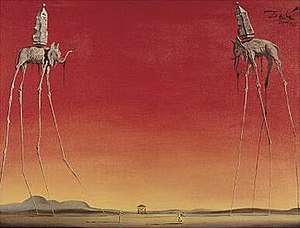The Elephants
The Elephants (Spanish: Los Elefantes) is a 1948 painting by the Spanish surrealist artist Salvador Dalí.[1]
| The Elephants | |
|---|---|
 | |
| Artist | Salvador Dalí |
| Year | 1948 |
| Medium | Oil on canvas |
| Location | Private collection |
Elephants in the work of Dalí
The elephant is a recurring theme in the works of Dalí, first appearing in his 1944 work Dream Caused by the Flight of a Bee Around a Pomegranate a Second Before Awakening, and also in The Temptation of Saint Anthony and Swans Reflecting Elephants. The Elephants differs from the other paintings in that the animals are the primary focus of the work, with a barren graduated background and lack of other content, where most of Dalí's paintings contain much detail and points of interest (for example Swans Reflecting Elephants which is somewhat better known within Dalí's repertoire than The Elephants [2]). The stork-legged elephant is one of the best-known icons of Dalí's work and adorns the walls of the Dalí Museum in Spain.[3]
Symbolism
There are various cultural depictions of elephants, where they are often viewed as symbols of strength, dominance and power due to their bulk and weight.[4] Dalí contrasts these typical associations by giving the elephants long, spindly, almost arachnid-like legs, once described as "multijointed, almost invisible legs of desire".[5] Dalí enhances the appearance of strength and weight by depicting the elephants carrying massive obelisks on their backs, however, on close inspection it can be seen that these weights are floating. The obelisks on the backs of the elephants are believed to be inspired by Gian Lorenzo Bernini's sculpture base in Rome of an elephant carrying an ancient obelisk,[6] and was mentioned in several communications of the artist, so can be considered a reliable claim.[2]
The Elephants is a good example of a surrealist work, creating a sense of phantom reality. "The elephant is a distortion in space", one critic explains, "its spindly legs contrasting the idea of weightlessness with structure";[5] "contrasting weight and space".[2]
References
- Robert Descharnes, Gilles Néret (1 August 2007). Salvador Dalí: 1904-1989. The paintings. Taschen. ISBN 3822838225.
- "Archived copy". Archived from the original on 2013-03-08. Retrieved 2013-07-26.CS1 maint: archived copy as title (link) pene art.com Retrieved on July 26, 2013
- "Salvador Dali Gallery – Memories of Surrealism : Space. Space is an element of art and it is something that every painting has including Dali's art work the Elephants Elephant". SalvadorDaliExperts.com. Archived from the original on 7 April 2013. Retrieved 12 December 2012.
- Retrieved July 26, 2013
- Dalí Universe Collection Archived 2008-12-01 at the Wayback Machine. County Hall Gallery. Retrieved on July 28, 2006.
- Michael Taylor in Dawn Adès (ed.), Dalí (Milan: Bompiani, 2004), p. 342